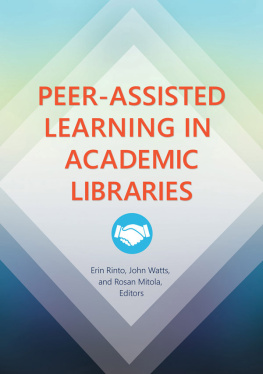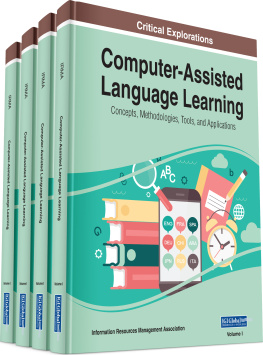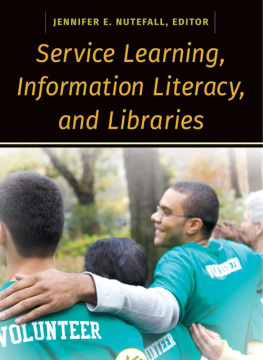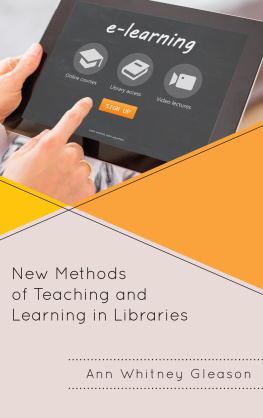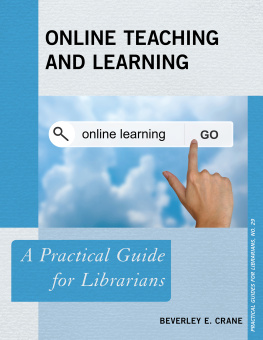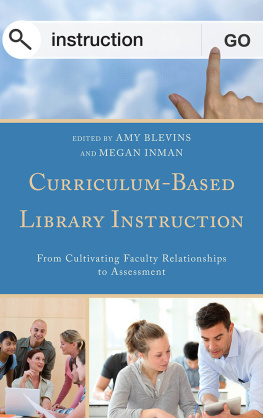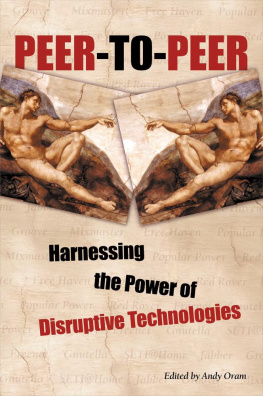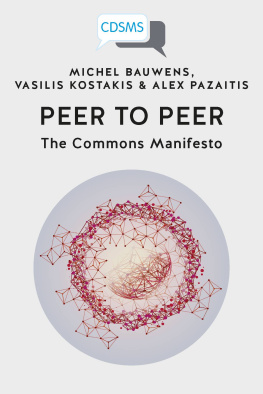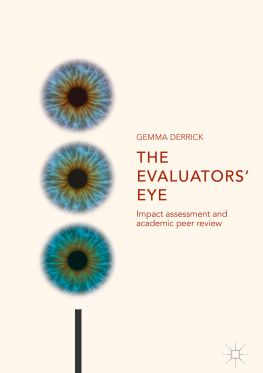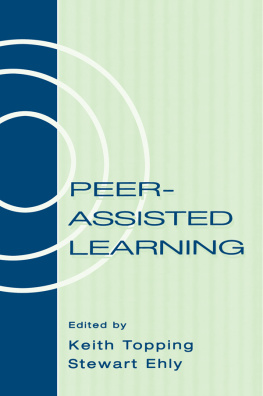Peer-Assisted Learning in
Academic Libraries
Peer-Assisted Learning in
Academic Libraries
Erin Rinto, John Watts, and Rosan Mitola, Editors
Foreword by Patricia Iannuzzi

Copyright 2017 Erin Rinto, John Watts, and Rosan Mitola
All rights reserved. No part of this publication may be reproduced, stored in a retrieval system, or transmitted, in any form or by any means, electronic, mechanical, photocopying, recording, or otherwise, except for the inclusion of brief quotations in a review, without prior permission in writing from the publisher.
Library of Congress Cataloging-in-Publication Data
Names: Rinto, Erin, editor. | Watts, John (Librarian), editor. | Mitola, Rosan, editor.
Title: Peer-assisted learning in academic libraries / Erin Rinto, John Watts, and Rosan Mitola, editors ; foreword by Patricia Iannuzzi.
Description: Santa Barbara, California : Libraries Unlimited, an Imprint of ABC-CLIO, LLC, [2017] | Includes bibliographical references and index.
Identifiers: LCCN 2017026075 (print) | LCCN 2017001567 (ebook) | ISBN 9781440846892 (ebook) | ISBN 9781440846885 (acid-free paper)
Subjects: LCSH: Student library assistantsUnited StatesCase studies. | Peer teachingUnited StatesCase studies. | Academic librariesRelations with faculty and curriculumUnited StatesCase studies. | Mentoring in library scienceUnited StatesCase studies. | ResearchStudy and teaching (Higher)Case studies. | Information literacyStudy and teaching (Higher)United StatesCase studies. | Library orientation for college studentsUnited StatesCase studies. | Libraries and collegesUnited StatesCase studies.
Classification: LCC Z682.4.S89 (print) | LCC Z682.4.S89 P44 2017 (ebook) | DDC 025.5/6770973dc23
LC record available at https://lccn.loc.gov/2017026075
ISBN: 978-1-4408-4688-5
EISBN: 978-1-4408-4689-2
212019181712345
This book is also available as an eBook.
Libraries Unlimited
An Imprint of ABC-CLIO, LLC
ABC-CLIO, LLC
130 Cremona Drive, P.O. Box 1911
Santa Barbara, California 931161911
www.abc-clio.com
This book is printed on acid-free paper 
Manufactured in the United States of America
We dedicate this book to
Flora and Stuart Mason,
whose vision and generosity made this program possible,
and the past, present, and future Mason Undergraduate Peer Research Coaches.
Contents
Patricia Iannuzzi
Annie Donahue, Carolyn Gamtso, and Kim Donovan
Brett Bodemer
Genevieve Schaack and Annie Zeidman-Karpinski
Pamela Martin
Erin Rinto, John Watts, and Rosan Mitola
Anna Esty, Alexis Gomez, Ramona Islam, Vegas Longlois, and Reed Lowrie
Theresa McDevitt and Malaika M. Turner
Tyler A. Dunn, Jan H. Kemp, and Ellen V. Blumberg
Jenny Wong-Welch
Clinton Baugess, Mallory Jallas, Meggan Smith, and Janelle Wertzberger
Michael Courtney and Kate Otto
Emilia R. Marcyk and Benjamin Oberdick
Joshua Vossler
Jessica Hronchek and Rachel Bishop
I have spent more than 30 years of my career framing academic libraries as partners in student learning: modeling action on various campuses, sharing strategies within our profession, and working on advocacy and curricular reform within higher education arenas ranging from professional associations to regional accreditation groups to private foundations. More than ever, I am convinced that academic libraries are uniquely positioned to contribute to student learning in and out of the classroom.
Our early efforts in articulating and embedding information literacy learning outcomes that overlap and integrate with critical thinking and oral and written communication have created a generation of librarians participating in campus conversations about student learning. We teach, we partner with classroom instructors on course and assignment design, and we intentionally design learning spaces and experiences outside of the classroom. We are likely the only unit on campus that contributes to student learning through both curricular and co-curricular experiences. We provide one-on-one instruction at service points, turning routine questions into teachable moments for guided inquiry. We employ pedagogy of place in reshaping our physical and virtual spaces to encourage a variety of student learning styles and preferences, supporting group and individual learning. We use our classrooms for formal instruction sessions and topical workshops, and we use our computer spaces to guide students as producers of their own knowledge, employing digital tools and techniques and practicing all the literacies that accompany them.
I have long supported the research claiming that teaching is the highest form of learning, which means that peer-assisted teaching and learning is a winwin environment for both peer leaders and peer learners. When you consider the library as creator and facilitator of intentionally designed peer learning experiences, you have a trifectaa three-way winning combination for the peer leaders, the peer learners, and the library!
The diversity of learning experiences created by libraries provides many opportunities to embed peer learning into those environments, and I have experimented with these practices for more than 25 years. Over time, I have experienced a series of aha moments, leading to further experimentation and innovation. In some cases, I designed experiences to encourage and nurture peer learning among students as our users. In other situations, I created programs for library student employees who were trained, mentored, and supported to function as peer teachers. One of my first experiences was almost unintentional, back in the late 1980s when technological innovation in the form of CD-ROM and locally hosted databases were made available to students and other library users for the first time. The role of librarians as intermediaries to information was removed, and users were catapulted into the role of direct consumer. I hired my first student rovers in those years to extend the reference reach into the computer help space and provide peer assistance with technology applications. But I noticed something from those first peer leaders: they excelled academically because they learned how to do research and they were extensively trained and provided opportunities for continual learning. They even began to bring back stories of introducing their classroom instructors to the latest databases acquired by the libraries.
The CD-ROM era quickly gave way to the Internet. These were difficult transition years for generations of library users, classroom faculty, and even librarians. Library anxiety was real, especially in first-generation college students, returning students who completed their education before the Internet, and international students adjusting to cultural and procedural differences in library environments. It was quickly obvious that students were more likely to ask for help from another student, than from an authority figure behind a desk.
Almost overnight, the passive study spaces provided by libraries to complement collections were morphing into learning spaces as computers proliferated and peers were used to extend the one-on-one instruction provided at reference desks and other service points. Almost unintentionally, libraries were extending their impact on co-curricular student learning, not just through new services provided by student employees, but to the student employees themselves.

